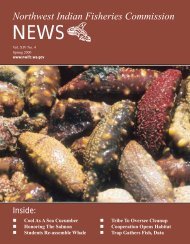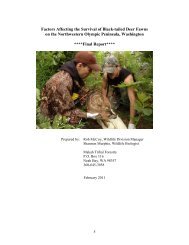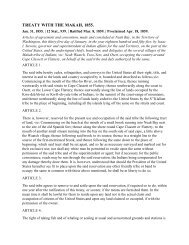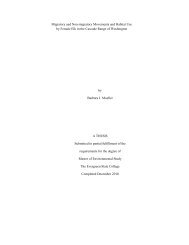Draft TRT Document â for Discussion Purposes ... - NWIFC Access
Draft TRT Document â for Discussion Purposes ... - NWIFC Access
Draft TRT Document â for Discussion Purposes ... - NWIFC Access
You also want an ePaper? Increase the reach of your titles
YUMPU automatically turns print PDFs into web optimized ePapers that Google loves.
<strong>Draft</strong> <strong>TRT</strong> <strong>Document</strong> – <strong>for</strong> <strong>Discussion</strong> <strong>Purposes</strong> – OK to circulateWe calculated catchment area <strong>for</strong> the entire basin (based on a topographicalGeographic In<strong>for</strong>mation Systems (GIS) model) and <strong>for</strong> accessible portions of each basin<strong>for</strong> Puget Sound streams using both known natural and manmade barriers (Williams et al.1975, Streamnet 2009). In large watersheds, such as the Skagit River, which containmajor tributaries (Appendix 3), the calculation of catchment area excluded portions of thewatershed above major upstream confluences (e.g., the lower Skagit River includes thearea from the river’s mouth to its confluence with the Sauk River). We adopted theseestimates as a preliminary step in developing a list of prospective steelhead DIPs.Additionally, estimates of stream length, stream area, and stream area adjusted <strong>for</strong>potential productivity were generated using GIS-based models. An intrinsic potential(IP) model to estimate productivity was adapted from the Interior Columbia <strong>TRT</strong> modeland based primarily on stream size and gradient. For Puget Sound steelhead wesimplified the model to only two stream gradient classes, more or less than 4% gradient,and three stream widths: 0-3 m, 3-50 m, and >50m (Figure 2). Stream habitat wasclassified as having low, medium, and high productivity (Figure 2). The different habitatclasses were then multiplied by a capacity factor (7.17 parr/100 m 2 and 0.0265spawners/parr) derived by Gibbons et al. (1985) from empirical data on Puget Soundsteelhead streams.Stream Habitat Rating Matrix (below natural barriers)Stream Width (bankful)0-3 m 3-50 m > 50 mStream 0.0 – 4.0% Low High ModerateGradient > 4.0% Low Low LowFigure 2. Stream habitat rating <strong>for</strong> streams <strong>for</strong> Puget Sound Steelhead. Stream size and gradientcategories were assigned by <strong>TRT</strong> members based on expert opinion. The <strong>TRT</strong> usedthese basin characteristics to calculate the intrinsic potential (IP) of basins in order toestablish whether a large enough population could be maintained under pristineconditions to ensure sustainability into the <strong>for</strong>eseeable future.Given the simplicity of this model and application of a single productivity factor, the<strong>TRT</strong> acknowledged that there is considerable uncertainty in the capacity estimates;however, the primary use of the estimates was to establish whether putative populationswere likely sufficiently large enough to be sustainable, rather than to estimate potentialcapacities <strong>for</strong> viability modeling. The <strong>TRT</strong> used the IP estimate <strong>for</strong> Snow Creek (XX) asa minimum value <strong>for</strong> identifying candidate DIPs. Independent tributaries were combinedto create presumptive DIPs, in some cases multiple iterations of independent tributarieswere assessed.Ecological In<strong>for</strong>mationThe fidelity with which salmonids return to their natal streams implies a closeassociation between a specific breeding aggregation and its freshwater environment. Theselective pressures of different freshwater environments may be responsible <strong>for</strong>differences in life history strategies among stocks. Miller and Brannon (1982)18









